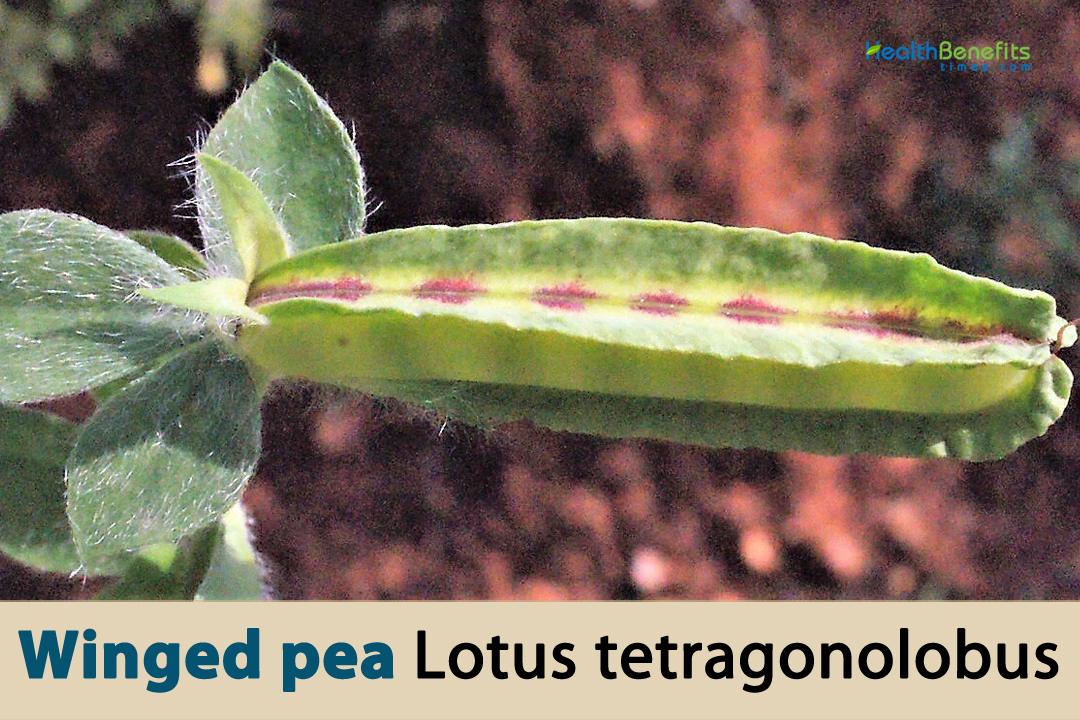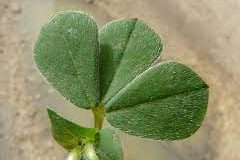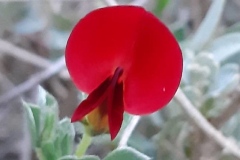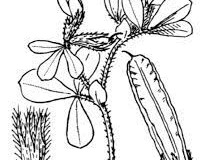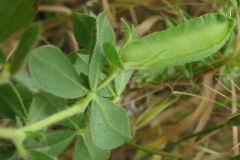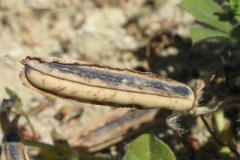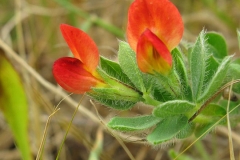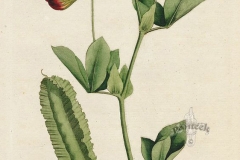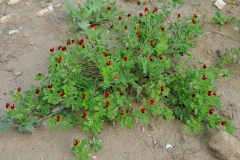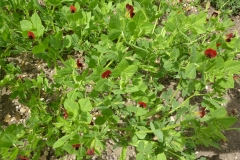| Winged pea Quick Facts | |
|---|---|
| Name: | Winged pea |
| Scientific Name: | Lotus tetragonolobus |
| Origin | Believed to have originated in tropical Africa or Southeast Asia |
| Colors | Green when young and turn brown as they mature |
| Shapes | Long and slender pod typically about 15-30 centimeters (6-12 inches) long |
| Taste | Nutty and slightly earthy taste, with a hint of sweetness |
| Major nutrients | • Protein • Dietary Fiber • Vitamin C • Vitamin B9 • Potassium • Iron • Calcium • Carbohydrate • Healthy Fats • Antioxidants • Minerals • Niacin • Thiamine • Zinc • Copper |
| Health benefits | Heart Health, Blood Sugar Control, Weight Management, Bone Health, Skin and Vision, Digestive Health, Anti-Aging, Eye Health, Blood Pressure Regulation, Improved Skin Texture, Healthy Hair, Aid in Anemia Prevention, Improved Bone Density, Alleviation of PMS Symptoms |
| Name | Winged pea |
|---|---|
| Scientific Name | Lotus tetragonolobus |
| Native | Believed to have originated in tropical Africa or Southeast Asia. It has been cultivated in various parts of Asia, including India, Indonesia, the Philippines, and Malaysia, as well as in several African countries |
| Common Names | Winged Pea, Asparagus Pea, Winged Lotus, Winged Tare, Winged Wild Pea, Winged Vegetable Pea, Winged Warty Pea, Four-angled Pea, Angle-podded Pea, Winged Tephrosia, Winged Vetchling, Winged Winter Vetch, Winged Tare Vetch, Winged Blue Vetch, Winged Groundnut, Winged Hoary-pea, Winged Podded Lotus, Winged Bean Pea, Winged Potato Bean, Winged Wild Vetch, Winged Wingnut, Asparagus Bean, Princess Bean, Winged Hyacinth Bean, Winged Lentil Vine |
| Name in Other Languages | Afrikaans: Vlerkie-ertjie Amharic: Kemshag (ከምሻግ) Arabic: Adas al-Janah (عدس الجناح), Bazella al-Janah (بازلاء الجناح), Qaranbûsh, Assâbe’ el ‘arûs Assamese: Pakhi Shak (পাখি শাক) Bengali: Potka Dal (পটকা ডাল), Chura Shim (চুড়া শিম) Bhojpuri: Pankhinwala Matar (पंखिनवाला मटर), Pawal (पवल) Bulgarian: Krilat grah (Крилат грах) Burmese: Pyetseinhti (ပြက်သိန်းသီး), Kan Pyin (ကန်ပြိုင်း), U kyu (ဥားကြိုး) Chhattisgarhi: Juarai Daal (जुअरई डाल), Senke Bira (सेनके बीरा) Chinese: Chìdòu (翅豆), Chi jia wan dou, Chì jiá bǎi mài gēn (翅荚百脉根) Croatian: Krilati grah, krilobod rumeni Czech: Okřídlený hrách Danish: Vingebønne, Kantbaelg, Aspargesært Dogri: Gawar Menda (ਗਵਾਰ ਮੇਂਡ਼ਲਾ) Dutch: Vleugelboon, Asperge-erwt, Rode hauwklaver English: Winged pea, Goa bean, Four-angled bean, Asparagus pea, Square podded pea, Winged lotus, Winged-pea, square-pod trefoil Estonian: Tiib-hernes Filipino: Balatong, Patani Finnish: Siipipapu, Parsaherne, Punaparsaherne French: Lotus Tétragone, Pois à ailes, Pois carré, Lotier rouge, Lotier cultivé, Pois asperge, Pois café, lotier pourpre, lotier tétragonolobe, tétragonolobe pourpre Garhwali: Asun (असुण) German: Flügelerbse, Spargelerbse, Echte Spargelerbse, Flügelerbse, Garten Spargelerbse, Rote Spargelbohne, rote Spargelerbse Greek: Agkathóloux (Αγκαθόλουξ), Fasóli me fterá (Φασόλι με φτερά) Gujarati: Kantholi (કંઠોળી), Gareeb Guvar (ગરીબ ગુવાર) Haryanvi: Pankh Daal (पँख दाल), Paar Dal (पाड़ दाल) Hausa: Ganyen asali Hebrew: Khoraf Gadol (חורף גדול) Hindi: Patika Daal (पटिका दाल), Turai Matar (तुराई मोटर) Hungarian: Szárnyas borsó Icelandic: Vængjurtarbaun Igbo: Okwunkwo agbado Indonesian: Kacang tupai Italian: Borcardo, Loto coltivato, Loto dei giardini, Loto rosso, Pisello caffe, Veccia pisella, casciateddi, ginestrone purpurea, pisello asparagio, pisello da caffè Japanese: Tsubasa mame (翼豆), Hirazuobi (ヒラズオビ) Javanese: Kacang besi Kashmiri: Pankh Dhaal (پنخ دھال), Bandarvang (बन्दरवङ्ग) Kannada: Alagi Huralikayi (ಅಲಗಿ ಹುರುಳಿಕಾಯಿ), Huruli Kaayi (ಹುರುಳಿ ಕಾಯಿ) Kebyle: Tadrunt Khasi: Sohlieh Khmer: Slout Bompong (ស្លូតបំពង) Kokborok: Haoulam (হাউলাম) Konkani: Ashalam (आशलं) Korean: Nalgae-kong (날개콩) Kumaoni: Murula (मुरुला) Lao: Phak phae (ຜັກແປ) Lithuanian: Sparnagūžis žirnis Latvian: Spārnišķīgais zirnis Maithili: Pankhinwala Matar (पंखिनवाल मटर) Malay: Kacang Sayap, Kacang terung Malayalam: Alakkipayar (അലക്കിപയർ), Alayikkaya (അലയിക്കായ) Manipuri: Khangkhok Lai (ꯂꯩꯄꯤ ꯑꯣꯡ) Marathi: Avachand (अवचांड), Karade Vatane (कारडे वाटाणे) Mizo: Sazova Nepali: Parikhapiro (परिखपिरो), Jimbū pharsī (जिम्बू फर्सी), Pankhe Farke Mask (पंखे फर्के मस्क) Norwegian: Vingebønne, aspargesert Odia: Pakshi Daala (ପକ୍ଷି ଡାଳ) Persian: Nokhod Park (نخود پرک) Polish: Groch skrzydlaty, Głąbigroszek szkarłatny Portuguese: Ervilha-de-asa, Feijão asa, Loto-vermelho Punjabi: Chariva Matar (ਚੜੀਵਾ ਮਟਰ) Quechua: Haccha Manila Rajasthani: Pankh Daal (पंख डाल) Romanian: Mazăre cu aripi Russian: Krylatka (Крылатка), Krylataya fasol (Крылатая фасоль), tetragonolobus purpurnyy (тетрагонолобус пурпурный), chetyrekhkryl’nik purpurnyy (четырехкрыльник пурпурный) Sanskrit: Shaktikarna (शक्टिकर्ण) Santali: Hanglum (हंगलुम) Serbian: Krilati grašak (Крилати грашак) Sindhi: Pank Van (پنک ون) Sinhala: Hanakada (හානාකඩ), Sumudu (සුමුදු) Slovak: Krídlatý hrach Slovenian: Krilati grah Sotho: Tlhakana-tlhoko Spanish: Hacha Manila, Bocha cultivada, Loto cultivado, cuernecillo, guisantillo rojo, saldana Swahili: Kunde, Kisherehe Swazi: Lidokotjane Swedish: Vingböna, Sparrisärt, Klöverärter Tamil: Alakki Pattani (அலக்கி பட்டாணி), Ala Pattani (அலா பட்டாணி) Tangkhul: Luimui Telugu: Alaki Battani (అలకి బట్టాణి), Ala Goruchu (అల గొరుచు) Thai: Thua Mi Pīk (ถั่วมีปีก), Thua Chub (ถั่วชุบ) Tswana: Tshwane Tulu: Alekanbu (ಅಲೆಕಂಬು) Turkish: Kanatlı Bezelye, Lufer çiç, al canavardişi Ukrainian: Krylatyy horokh (Крилатий горох), tetrahonolobus purpurovyy (тетрагонолобус пурпуровий) Upper Sorbian: Čerwjeny štyrjownik Urdu: Parinde Daal (پرندے دال) Vietnamese: Đậu cánh Xhosa: Ihopho lezilwane Yoruba: Ewé ofírúnjé Zulu: Ihluzi lomculo |
| Plant Growth Habit | Annual herbaceous, leguminous plant |
| Growing Climates | Often grows in open, sandy, or rocky habitats, including coastal areas, Cultivated ground and vineyards |
| Soil | Grows best in dirt that drains well and let’s air flow through it. It can grow in a range of soils, such as sandy loam, clay, or loamy soils. |
| Plant Size | Grow to be about 3 to 6 feet (approximately 0.9 to 1.8 meters) tall and 2 to 4 feet (approximately 0.6 to 1.2 meters) wide |
| Root | Plants typically have a fibrous root system that spread out horizontally and help stabilize the plant in the soil |
| Stem | The stem of the winged pea is a flexible, twining or climbing stem. It is generally slender, cylindrical, and green in color. The stem can become woody at the base as the plant matures. |
| Bark | Does not have true bark like woody trees and shrubs |
| Leaf | Compound leaves are arranged alternately along the stem that typically consists of 3 to 5 leaflets. The leaflets are oblong or lance-shaped and have pointed tips. They are usually dark green in color and can measure several inches in length |
| Flowering season | June to August |
| Flower | Individual flowers are relatively small, typically around 1 to 2 centimeters (0.4 to 0.8 inches) in diameter. They come in various colors, including shades of pink, purple, and white, depending on the variety |
| Fruit Shape & Size | Long and slender pod typically about 15-30 centimeters (6-12 inches) long |
| Fruit Color | Green when young and turn brown as they mature |
| Seed | Oval or kidney-shaped, with a slightly flattened appearance. The size of the seeds can vary, but they are usually about 1-2 centimeters (0.4-0.8 inches) in length |
| Flavor/Aroma | Earthy and slightly nutty |
| Taste | Nutty and slightly earthy taste, with a hint of sweetness |
| Plant Parts Used | Leaves, roots and seeds |
| Propagation | By seed, Stem Cuttings, Tuber Division |
| Lifespan | About 4 to 9 months, depending on the specific climate and growing conditions |
| Season | September to October |
| Varieties |
|
| Major Nutrition |
|
| Available Forms |
|
| Health benefits |
|
Plant Description
“Lotus” comes from the ancient Greek word “lōtos” (λωτός). In Greek, the word “lōtos” could mean a lot of different plants. This word was often used to describe flowers that smelled good. There is likely a link or similarity between the word “Lotus” in the formal name and these old plants. The word “tetragonolobus” comes from the Greek words “tetragōnon” (τετράγωνo½), which means “four-angled,” and “lobos” (λόβoς), which means “pod” or “lobe.” The Winged Pea’s four-winged pods are probably where the name comes from. Flight pods on this plant are one thing that makes it stand out. In the old days of gardening, the winged pea was a very important food source. People ate the young, soft pods as vegetables a lot of the time, and the seeds were used in a lot of different foods, like soups, stews, and sauces. In some places, the leaves of the Winged Pea plant were also eaten.
Appropriate growing environment of winged pea
The Winged Pea thrives in specific growing environments that are well-suited to its tropical and subtropical nature. Here are the key factors that make up an appropriate growing environment for Winged Pea:
- Temperature: The Winged Pea likes it best when it is warm and tropical or subtropical. The best temperatures for it to grow are between 21°C and 32°C, or 70°F to 90°F. Plants should not be planted in places where it often freezes because the frost can hurt or kill them.
- Rainfall: For good growth, Winged Pea needs the right amount of water. It does best in places where it rains evenly throughout the growing season. As long as it is established, it can also handle short times of dryness. Most people think that 800 to 1,200 mm (31 to 47 inches) of rain a year is enough.
- Sunlight: For winged pea plants to grow and produce a good crop, they need a lot of sunlight. They do best when they get at least 6 to 8 hours of direct sunshine every day.
- Soil: Winged Pea grows best in dirt that drains well and let’s air flow through it. It can grow in a range of soils, such as sandy loam, clay, or loamy soils. It does, however, like soils that are slightly acidic to neutral, with a pH range of 6.0 to 7.0.
- Watering: The best soil for Wing Pea is one that drains well and let’s air flow through it. It can grow in a variety of soils, including sandy loam, clay, and loamy soil. It does, however, like soils that are neutral to slightly acidic, with a pH between 6.0 and 7.0.
- Support: The branches of Winged Pea plants need something to climb on so they can grow. To keep the plants from spreading out on the ground, you must provide a trellis, fence, or other upright support structure.
- Spacing: When planting Winged Pea seeds or plants, make sure to leave enough space between them so that air can flow and light can reach them. In rows, plants should be about 6 to 8 inches apart, and rows should be 2 to 3 feet apart.
- Pest and Disease Management: Keep an eye out for common diseases and pests that can hurt Winged Pea plants in your area. To lower the risk of infestations, take the right steps to get rid of pests and follow good farming practices.
- Crop Rotation: Crop rotation can help keep the soil healthy and free of diseases that come from the earth. Winged Pea shouldn’t be planted in the same spot every year.
- Harvest Timing: For the best taste and quality, pick Winged Pea pods when they are still young and soft. When pods are too ripe, they can get tough and woody.
Roots
The roots of winged pea plants are usually made of fibers. The main root, called the taproot, doesn’t last long in a fibrous root system. It is quickly replaced by a network of thin, fibrous roots. These long, thin roots spread out crosswise and help the plant stay put in the ground. On the very small scale, root hairs can be seen on the root system’s surface. Root hairs are tiny, finger-like extensions of root cells that make the roots’ surface area much bigger. The job of these plants is to take water and nutrients from the dirt. Like other leguminous plants, winged peas can make root nodules with the help of rhizobia, which are bacteria that fix nitrogen in the soil. These root nodules are usually found on the roots. They are special structures where the plant and rhizobia work together to help each other. Rhizobia take nitrogen from the air and change it into a form that plants can use. This makes the soil more fertile.
Some types of flying pea can grow storage roots that are thick and tuberous. These roots store carbs and other nutrients, giving the plant energy when it’s under a lot of stress or when the conditions for growth aren’t ideal. These roots can be different shapes and sizes. The main root of the winged pea usually doesn’t last long and is replaced by fibrous roots. However, the root structure can be different between varieties and growing situations. A taproot may sometimes stay in place for a while. The depth of the winged pea’s roots can change based on the type of soil, the amount of water available, and other natural factors. Roots can go pretty deep into the ground to get to water and nutrients in soils that drain well.
Stem
Winged pea plants are herbaceous vines that can grow from one year to the next. They rise. They can grow to be at least a few meters long. The stem of the flying pea is bendy and can twine or climb. Most of the time, it is thin, tubular, and green. Over time, the stem can get woody at the base as the plant grows. The stem is broken up into parts called internodes. These are the parts of the stem that are between where the leaves or branches start to grow. Since the internodes are longer, the stem can get bigger or longer.
The vascular system inside the stem is made up of xylem and phloem cells. Phloem moves sugars made in the leaves to other parts of the plant, and xylem moves water and nutrients from the roots to the leaves. The part of the stem that grows new leaves is called the peak. At this point, new cells are made, which lets the stem keep growing longer. The tip is usually bendable, so it can change direction if the plant needs to. Lenticels are small, bumpy parts on the stem’s surface. Their job is to let gas move between the stem’s cells and the air around it, which is necessary for breathing. The stem may have different amounts of thickness and shape. The bottom part of the stem can sometimes turn into woody while the top part stays grass, especially in older plants.
Bark
Since the winged pea is an herb, it doesn’t have real bark like trees and plants that are made of wood. What’s on the outside of the stem is called the skin. It’s made up of one layer of cells that are very close together and covers the whole stem. In addition to keeping the underlying organs safe, the epidermis also helps the body lose less water through transpiration. There may be a thin, waxy layer on top of the epidermal cells of the flying pea stem. This layer is called the cuticle. The cuticle helps keep water in the plant and protects it from things in the surroundings that can be harmful. While the epidermis can be any color or feel, it is usually green and smooth in the young, growing parts of the plant. The skin may get tougher and less green as the plant grows older, especially near the base of the stem. However, it does not get the bark that woody plants have.
Leaves
The leaves are compound, which means that each leaf has several leaflets that are all connected to the same stalk. These compound leaves are pinnately compound, which means that the leaflets are lined up along the center axis in a feather-like pattern. The complex leaves are lined up along the stem in a pattern of back and forth. This means that as you move up the stem, each leaf is connected at a different spot, going from side to side. There are usually three to five leaflets on each complex leaf, but the number can be different. The leaves are long or lance-shaped and end in a point. Most of the time, they are dark green and can be several inches long. The leaves have big veins that run through them. These veins support the structure and move water and nutrients around the plant. Most of the time, the veins are raised on the leaflet’s upper side.
The leaves’ top surface is smooth and shiny, while the bottom surface is a little paler and may have small hairs running along the veins. To connect each leaflet to the leaf stalk, the common petiole, there is a small stem called a petiolule. The leaves’ edges can be whole (smooth) or slightly serrated (with small projections that look like teeth). The exact look may be different between types of Winged Pea. Leaflets come in a range of sizes, but most are medium-sized. Their lengths can be anywhere from a few inches to about a foot, based on how old the plant is and how it is growing. In nature, the leaves tend to spread out and sometimes climb up. Tendrils are made by the plant that helps it connect to nearby structures so it can grow. Much like the leaves of most other plants, the Winged Pea’s leaves do photosynthesis, which is how the plant turns sunshine into energy and food. The chloroplasts of leaf cells are where photosynthesis takes place.
Flowers
Inflorescences are the groups of flowers that the plant makes. Most of the time, these flower clusters are racemes, which are long groups of flowers grouped along a central stem. The flower heads are pretty small, measuring only 0.4 to 0.8 inches (1.2 to 2 centimetres) across. Depending on the type, they come in different colors, such as pink, purple, and white. Most Winged Pea flowers have five petals that are joined together at the base. The flower has a unique shape that looks a bit like a butterfly or pea flower because of these wings. The flower’s five petals can be broken down into three separate groups:
The keel is made up of the two bottom wings that are joined together along their edges. The sexual parts of the flower are protected by this keel. There is a big petal at the back of the flower that is called the standard or flag. It stands tall and covers the other flowers most of the time. The last two flowers are called wings, and they go on either side of the keel. These petals help keep the reproductive parts safe and bring in pollinators. The sexual parts of the animal are inside the keel. The flower has both male and female parts that help it reproduce. The male parts of the flower are made up of ten stamens, which are the cells that make pollen. Usually, these stamens join together to form a tube that goes around the female parts. The female flower part has one pistil, which has the stigma (where sperm comes in), the style (a thin tube that connects the stigma to the ovary), and the ovary (where the seeds will grow). Bees and other insects are drawn to the colorful petals and nectar that winged pea flowers make and spread the pollen. Pollen moves from the stamens to the stigma during pollination. This makes it easier for the sperm to fertilize the egg and for the seed to grow.
Fruits
Fruit is a long, thin pod that is often called a “winged pod” because of the way it looks with its four wings. Because the wings are along the sides of the pod, it has a square or rectangular shape. While the pods can be any length, most are between 15 and 30 centimetres (6 to 12 inches) long. The color can be different based on the type and stage of maturity. To grow up, they can change color from green to brown. As the pods age, they get stronger and more woody. The pod looks like a rectangle because it is split into four parts by four long, visible wings. From the pod’s base to its tip, these wings reach. The pods are soft and tasty when they are young and fresh. But as the pods get older, they get harder and more fibrous, which makes them less good for eating. When the pods are fully grown, they have many seeds grouped in rows inside them. The seeds are inside the pod, surrounded by a soft tissue.
Seeds
The seeds of winged peas are usually oval or kidney-shaped and look a little flattened. The seeds can be different sizes, but most of the time they are between 0.4 and 8 inches long. The seed coat, also called testa, is the outside layer of the seed. It’s pretty thin, smooth, and light brown most of the time. The seed coat keeps the egg and endosperm inside safe. If the conditions are right, the baby will grow into a young plant from the seed. When it comes to the Winged Pea seed, the embryo is inside the seed coat. It has a tiny shoot that will become the stem and one or two cotyledons that will become the seed leaves and store nutrients.
Different varieties of winged pea
Winged Pea is a versatile and nutritious legume that comes in various varieties and cultivars, each with its own unique characteristics. Here are some of the different varieties of Winged Pea:
- Green-Podded Winged Pea: People often grow this type of Winged Pea because its pods are green. For cooking, the pods are picked when they are still young and soft.
- Purple-Podded Winged Pea: The name of this type of plant says that its pods are purple. When they are young, these pods can also be eaten and are used in the same way as green-podded types.
- White-Seeded Winged Pea: The seeds from this type are usually white or cream-colored. You can get a lot of protein from the seeds, and they are used in cooking and many traditional recipes.
- Brown-Seeded Winged Pea: Brown seeds Fruits of some types of winged pea have brown seeds. Most of the time, these seeds are used in soups, curries, and snacks, among other things.
- Two-Winged Winged Pea: On some types of Winged Pea, the pods have two large wings that run along both sides of the pod. These wings make the pods stand out from other plants.
- Four-Winged Winged Pea: The four-winged types of Winged Pea have pods that have four wings, one on each side. Having these wings makes the species unique, and they also help spread seeds.
Health benefits of winged pea
Winged pea or Goa bean is a nutritious leguminous vegetable that offers several health benefits when consumed as part of a balanced diet. Here are detailed health benefits of winged pea:
1. Antioxidants
Vitamin C and carotenoids like beta-carotene are some of the antioxidants that are found in winged pea. Free radicals can damage cells and cause oxidative stress. Antioxidants help protect cells from this damage, which may lower the risk of getting chronic diseases like heart disease and cancer.
2. Heart Health
The fibre and potassium in winged pea can help keep your heart healthy. Fiber in the diet lowers cholesterol, and potassium in the diet helps keep blood pressure in check, which lowers the risk of high blood pressure and heart disease.
3. Blood Sugar Control
The fiber in winged pea slows down the digestion of glucose, which can help keep blood sugar levels steady. This can be especially helpful for people who already have diabetes or are at risk of getting it.
4. Weight Management
Its fiber content makes you feel full, which can help you control your hunger and eat fewer calories overall, which can help you maintain your weight or lose weight.
5. Bone Health
The calcium in winged pea helps keep bones healthy and lowers the risk of osteoporosis and broken bones.
6. Skin and Vision
Vitamin A is very important for keeping your skin and eyes healthy. It helps skin cells grow and heal, and it also helps keep the eyes and mucous passages healthy.
7. Immune Support
Vitamin C is known for making the defense system stronger. Because it makes more white blood cells and antibodies, it helps the body fight off infections and diseases.
8. Anti-Inflammatory
Some studies show that winged pea may help reduce inflammation, which could be useful for people who have diseases like arthritis that cause chronic inflammation.
9. Digestive Health
The fiber in winged pea not only helps you have normal bowel movements, but it also helps keep your digestive system healthy in general. It helps good bacteria grow in the gut, which can help keep the gut microbiome healthy.
10. Anti-Cancer Potential
Winged pea has fiber that not only helps you go to the bathroom normally but also keeps your digestive system healthy in general. It makes good bacteria grow in the gut, which is good for the gut microbiome.
11. Anti-Aging
Fiber in winged pea not only helps you go to the bathroom regularly, but it also keeps your digestive system healthy in general. The gut microbiome benefits from having more good bugs.
12. Eye Health
Besides vitamin A, flying pea also has nutrients that are good for your eyes, such as lutein and zeaxanthin. Some of these chemicals are good for the retina and may help lower the chance of age-related macular degeneration and cataracts.
13. Blood Pressure Regulation
By blocking the effects of sodium, the potassium in winged pea can help keep blood pressure in check. A diet high in potassium is linked to a lower risk of high blood pressure and heart problems that are connected to it.
14. Folate Content
Folate is very important during pregnancy because it helps keep growing babies from having problems with their neural tubes. Folate is found in winged pea, which makes it a good food for pregnant women to eat.
15. Improved Skin Texture
Because it has a lot of vitamins and minerals, especially vitamin C and calcium, winged pea can help your skin look and feel better.
16. Healthy Hair
Winged pea is good for your hair because it has a lot of protein. Protein is very important for hair cells to grow and stay strong.
17. Aid in Anemia Prevention
The iron in winged pea can help keep you from getting iron-deficiency anemia, a disease that causes you to feel tired and have low red blood cell counts.
18. Improved Bone Density
Calcium, along with minerals like magnesium and phosphorus that can be found in winged pea, can help keep bones strong and lower the risk of getting osteoporosis.
19. Alleviation of PMS Symptoms
For some women, eating foods like winged pea may help with their premenstrual syndrome (PMS) symptoms because they are high in nutrients and may help keep their mood stable.
20. Hydration
Winged pea is mostly water, which helps you stay hydrated, especially when it’s hot outside.
Culinary uses of winged pea
The winged pea is a tropical legume that is not as commonly used in culinary dishes as some other legumes, but it offers a unique flavor and nutritional profile. Here are some culinary uses and ideas for incorporating winged peas into your cooking:
- Stir-Fry: To make stir-fry, you can use winged peas. To make the winged peas a little softer, just blanch or steam them. Then, stir-fry them with other veggies, protein (like tofu, chicken, or shrimp), and any sauces or seasonings you like.
- Salads: To make salads taste fresh and crunchy, add blanched or raw winged peas. They go well with many kinds of salad greens and other veggies. When mixed with vinaigrette sauce, winged peas taste mild and nutty.
- Curries: You can use winged peas in both veggie and meat curies. They soak up the curry sauce’s flavors and give the dish a unique texture.
- Soups: You can add wing peas to soups and stews to taste better and add energy. They taste great in hearty veggie soups or mixed in with bean soups.
- Fritters: Blend or mash the peas with other things like flour, herbs, and spices to make flying pea fritters. You can pan-fry or deep-fry the cakes until they are golden brown.
- Dips and Spreads: When you blend cooked winged peas with garlic, lemon juice, tahini, and olive oil, you get a unique hummus called winged pea hummus. You can make a creamy dip by mixing them with yogurt and vegetables.
- Rice and Grain Bowls: For more energy and texture, cook some winged peas and add them to bowls of rice or grains. You can add them to Buddha bowls or grain salads and really like them.
- Pasta: Chopped cooked winged peas can be added to pasta recipes to make them more protein-rich and interesting. With garlic, olive oil, and Parmesan cheese, they taste great.
- Side Dishes: You can cook winged peas with garlic, butter, and herbs and serve them as a side meal. You can also roast them in the oven to make them crispy.
- Pickling: Winged peas can be kept fresh by pickling them, and they can also be used as a garnish or addition to other foods. If you pickle winged peas, you can add a tangy and crunchy taste to sandwiches and salads.
- Sautéed Side Dish: For an easy but tasty side dish, sauté winged peas with garlic, onions, and any spices you like.
- Winged Pea Pesto: Add garlic, nuts (like almonds or pine nuts), olive oil, fresh basil or cilantro, and split peas to make a pesto sauce. It can be used to make pasta sauce or a spread for wraps and sandwiches.
- Winged Pea Soup: To make a creamy winged pea soup, mix cooked winged peas with veggie broth and your favorite herbs and spices. Add some fresh herbs or a spoonful of yogurt as a garnish.
- Winged Pea Salsa: To make a tasty salsa, chop up winged peas and mix them with diced tomatoes, onions, cilantro, lime juice, and chili peppers. It goes well with tacos, Mexican chips, or grilled meats.
- Winged Pea Pizza Topping: One different way to top pizza is with sliced or diced winged peas. You can use them to give your pizzas a fresh, crunchy touch.
- Winged Pea and Rice Pilaf: Cooked winged peas can be turned into a tasty side dish by adding spices, dried fruits, and nuts to a rice pilaf.
- Winged Pea Casseroles: If you want to make a creamy chicken and winged pea casserole or a veggie pasta bake, add winged peas to them.
- Winged Pea Wraps: For a quick and healthy wrap, mix cooked winged peas with your favorite veggies and a sauce or dressing of your choice. Place the mixture in tortillas or flatbreads.
- Winged Pea and Cheese Stuffed Pastries: Fill pastry dough with a mix of cheese, herbs, and winged peas to make stuffed cakes or turnovers. Bake until its golden brown and tastes great.
- Winged Pea Smoothies: Winged peas can be added to green smoothies after they have been blanched or cooked, but this is not very usual. For sweetness, eat them with fruits like berries or bananas.
- Winged Pea Tacos: You can make veggie or vegan tacos with winged peas as the main ingredient and any taco seasonings and toppings you like.
- Winged Pea Grain Bowls: To make hearty grain bowls, mix cooked winged peas with grains like couscous or quinoa, roasted veggies, and a tasty dressing.
- Winged Pea Omelets or Scramble: If you want a protein-rich breakfast or lunch, add cooked winged peas to omelets or scrambled eggs.
Other uses of winged pea
In addition to their culinary uses, winged peas have some non-food uses and applications
- Ornamental Plant: Winged pea plants can be grown for their pretty leaves and unique flowers, which makes them good for use as landscaping and yard plants.
- Cover Crop: Cover crops made from winged peas can help the land grow better. They can fix nitrogen in the soil, which makes them useful for farming for crop rotation and improving the soil.
- Livestock Forage: Animals, like horses and chickens, can eat the leaves of winged pea plants as forage, which gives them a healthy source of green food.
- Soil Erosion Control: Winged pea plants can help stop soil erosion because they grow quickly and have thick leaves, especially on slopes and other places that are prone to erosion.
- Fiber Production: In some places, the fibers taken from the stem of the winged pea plant have been used to make traditional clothes and nets.
- Biofuel Production: Some study has looked into how winged pea plants could be used to make biofuels, since their seeds have a lot of oil in them.
- Natural Pesticide: Extracts from flying pea plants could be used to naturally kill pests and keep bugs away.
- Composting: The plant parts, like stems and leaves, can be used as organic matter in compost piles to help the land get better.
- Educational Purposes: In places like schools and botanical parks, winged pea plants are sometimes grown to teach about plant biology and farming.
- Natural Dye: In the past, the flowers and seeds of this plant were used to make natural dyes for clothes and linens, which came in different shades of purple, blue, and green.
- Animal Feed: In addition to being used as food for animals, the seeds can be turned into animal feed, which gives animal’s protein and nutrients.
- Crafts: People who are into crafts can use winged pea pods to make things like natural jewelry or charms. Adding the pods’ unique shape and texture to art projects can make them more interesting.
- Green Manure: Winged pea plants can be grown as a green manure crop. These plants are grown and then tilled back into the earth to make it healthier and add more nutrients.
- Hedgerows and Windbreaks: Because they grow quickly and have thick leaves, winged peas can be used as hedgerows or windbreaks to keep other crops safe from strong winds and stop soil loss.
- Soil Improvement: Winged pea plants have roots that help break up hardened soil, which makes the earth better for structure and air flow. This could be useful for farming and gardens.
- Erosion Control Blankets: Winged pea vines that have been dried and processed can be used to make erosion control blankets or mats that keep soil on hills stable and stop it from washing away.
- Bioactive Compounds: There are bioactive substances in winged pea plants that could be used in the development of medicines and health supplements.
- Biodiversity and Habitat: As part of landscaping efforts to encourage variety and make homes for helpful insects and animals, the winged pea plant can be used.
Side effects of winged pea
Winged pea like many other plants and foods can have side effects or potential issues when consumed. It’s important to be aware of these considerations:
- Gastrointestinal Distress: Some people may have stomach problems like gas, bloating, or diarrhea after eating winged peas. This might happen more often if you eat a lot of them or if they are not cooked all the way through.
- Allergic Reactions: It is rare for winged peas to cause allergic responses, but they can happen. Itching, hives, swelling of the face or throat, trouble breathing, and in the worst cases, anaphylaxis is all signs of an allergic response. If you think you might have an allergy, you should see a doctor right away.
- Anti-Nutrients: Like many other legumes, winged peas have natural chemicals called anti-nutrients, like phytic acid and tannins. Minerals like iron and calcium can’t be absorbed as well when these chemicals are present. Anti-nutrients can be lowered in winged peas by cooking them or letting them soak.
- Oxalates: A lot of the parts of winged peas, especially the leaves, have chemicals in them called oxalates that can help some people get kidney stones. If you have had kidney stones in the past or are at risk for getting them, you should eat winged peas in moderation and talk to a doctor.
- Purines: People who have gout or certain metabolic disorders may need to reduce the amount of purines they eat because they can make the body make more uric acid. Purines are found in wing peas, so people with gout or diseases similar to it should be careful and talk to a doctor.
- Medicinal Interactions: Some metabolic diseases and people with gout may need to cut back on the amount of purines they eat because they can cause the body to make more uric acid. Wing peas contain purines, which means that people with gout or diseases that are similar to it should be careful and talk to a doctor.
- Uncooked Parts: It’s important to cook winged peas all the way through, because eating them raw or not cooked enough can make your stomach hurt and make it harder for your body to absorb the nutrients.
- Cyanogenic Glycosides: There are very small amounts of cyanogenic glycosides in winged peas, which are chemicals that can release cyanide when eaten. This is usually not a problem unless very large amounts are eaten. Cyanogenic glycosides are broken down by cooking.
- Pregnancy and Breastfeeding: Women who are pregnant or nursing should be careful when adding new foods to their diet. Winged peas are one of those foods. Talk to a doctor or nurse to make sure they are safe for you to eat during this time.
References:
https://www.itis.gov/servlet/SingleRpt/SingleRpt?search_topic=TSN&search_value=516137#null
https://npgsweb.ars-grin.gov/gringlobal/taxon/taxonomydetail?id=22745
https://pfaf.org/USER/Plant.aspx?LatinName=Lotus+tetragonolobus
https://gd.eppo.int/taxon/TTGPU
https://uk.inaturalist.org/taxa/138906-Lotus-tetragonolobus
https://plants.usda.gov/home/plantProfile?symbol=TEPU6


